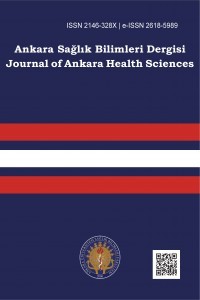HEMŞİRELİK ÖĞRENCİLERİNİN CİNSEL SAĞLIK BAKIMI VERMEYE İLİŞKİN TUTUM VE İNANÇLARI
Cinsel Sağlık, Cinsel Sağlık Bakımı, Hemşirelik, Bakım, Öğrenci Hemşire
ATTITUDE AND BELIEF OF NURSING STUDENTS TOWARDS SEXUAL HEALTH CARE
care, nursing, nursing student, sexual health, sexual health care,
___
- Aaberg, V. 2016. The state of sexuality education in baccalaureate nursing programs. NurseEducToday 44:14-19. Ayhan, H., Iyigün, T.S., Coskun, H. 2010. Turkish version of the reliability and validity study of the sexual attitudes and belief survey. Sex and Dis 28:287-296. Bal, D.N. 2014. The Nurse’s Attitudes and Beliefs Towards Sexuality. HEAD;11(3):38-42. Balami, J.S. 2010. Ageing and sexuality: A neglected issue among care home residents. In: N.E. Peterson & W. Campbell, editors. Handbook on Sexuality. New York, NY: Nova Science Publishers. pp: 267. Blakey, E.P., Aveyard, H. (2017). Student nurses' competence in sexual health care: A literature review. J Clin Nurs. 26(23-24):3906-3916. Cesnik, V.M, Zerbini, T. (2017). Sexuality education for health professionals: A literature review. Estudos de Psicologia (Campinas), 34(1), 161-172. Conover, W.J. 1980. Practical Nonparametric Statistics. 2nd ed. John Wiley & Sons, New York. Dattilo, J., Brewer, M.K. 2005. Assessing clients’ sexual health as a component of holistic nursing practice: senior nursing students share their experiences. J HolistNurs 23: 208–219. Davis, B.D., Gamel, C., Hengeveld, M. 1993. Nurses’ provision of teaching counseling on sexuality: A review of the literature. J Adv Nurs 18, 1219-1227. Haboubi, N.H., Lincoln, N. 2003. Views of health professionals on discussing sexual issues with patients. Disabil Rehabil 25: 291– 296. Hautamaki, K., Miettinen, M., Kellokumpu-Lehtinen P.L. et al. 2007. Opening communication with cancer patients about sexuality-related issues. Cancer Nurs 30, 399-404. Huang, C.Y., Tsai, L.Y., Tseng, T.H. et al. 2013. Nursing students’ attitudes toward sprovision of sexual health care in clinical practice. J Clin Nursing 22:3577-3586. Jaarsma, T., Stromberg, A., Fridlund, B. et al. 2010. Sexual counseling of cardiac patients: nurses' perception of practice, responsibility and confidence. European Journal of Cardiovascular Nursing 9 (1):24-29. Kong, S.K.F., Wu, L.H., Loke, A.Y. 2009. Nursing students' knowledge, attitude and readiness to work for clients with sexual health concerns. J Clin Nurs 18(16):2372-2382. Kotronoulas. G., Papadopoulou. C., Patiraki. E. 2009. Nurses' knowledge, attitudes, and practices regarding provision of sexual health care in patients with cancer: critical review of the evidence. Support Care Cancer 17(5):479-501. Melo Ade, S., Campos de Carvalho, E., Rotter Pelá, N.T. 2007. Proposed revisions for the nursing diagnoses sexual dysfunction and ineffective sexuality patterns. Int J Nurs Terminol Classif.18(4):150-5. Reynolds, K.E., Magnan, M.A. 2005. Nursing attitudes and beliefs toward human sexuality, collaborative research promoting evidence-based practice. Clin Nurse Spec 19(5):255-259. Sung, S.C., Husang, H.C., Lin, M.H. 2015. Relationship Between the Knowledge, Attitude, and Self-Efficacy on Sexual Health Care for Nursing Students. J Prof Nurs 31(3):254-261. Sung, S.C., Lin, Y.C. 2013. Effectiveness of the sexual health care education in nursing students' knowledge, attitude, and self-efficacy on sexual health care. Nurse Educ Today 33(5):498- 503. Sung, S.C., Yeh, M.Y., Lin, Y.C. 2010. An exploration of the nurses' perspectives and their current practice on sex consultation. Formosan Journal of Sexology 16(1):1-16. Taylor, B., Davis, S. 2006. Using the extended PLISSIT model to address sexual healtcare needs. Nurs Stand. 21(11):35-40. World Health Organisation. 1974. Teaching of Human Sexuality in Schools for Health Professionals. Geneva: World Health Organisation. World Health Organisation. 2006. Defining Sexual Health Report of a Technical Consultation on Sexual Health 28–31 January 2002, Geneva: World Health Organisation.
- ISSN: 2146-328X
- Yayın Aralığı: Yılda 2 Sayı
- Başlangıç: 2012
- Yayıncı: Ankara Üniversitesi
SAĞLIK BİLİMLERİ FAKÜLTESİ ÖĞRENCİLERİNİN ENGELLİLERE YÖNELİK TUTUMLARI
Nazan ÇAKIRER ÇALBAYRAM, Menekşe Nazlı AKER, Büşra AKKUŞ, Fatma Kübra DURMUŞ, Samet TUTAR
TOPLUMSAL CİNSİYET DERSİNİN TOPLUMSAL CİNSİYET ALGISINA ETKİSİ
İlknur Münevver GÖNENÇ, Şenay TOPUZ, Neslihan YILMAZ SEZER, Serkan YILMAZ, Nuriye BÜYÜKKAYACI DUMAN
SAPONİNLER VE DİABETES MELLİTUS ÜZERİNE POTANSİYEL ETKİLERİ
HEMŞİRELİK ÖĞRENCİLERİNİN CİNSEL SAĞLIK BAKIMI VERMEYE İLİŞKİN TUTUM VE İNANÇLARI
Menekşe Nazlı AKER, Esra USLU, Pınar TUNÇ TUNA, Bilsel MOLU
YETİŞKİN BİREYLERDE CİNSİYETİN ORTOREKSİYA NERVOZA EĞİLİMİNE ETKİSİ
Esen YEŞİL, Burak TURHAN, Damla TATAN, Ceren ŞARAHMAN, Mendane SAKA
ŞİZOFRENİDE İLAÇ TEDAVİSİNE UYUM VE PSİKİYATRİ HEMŞİRESİNİN ROLÜ
